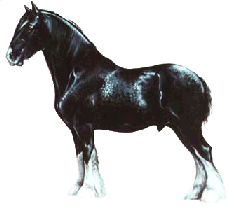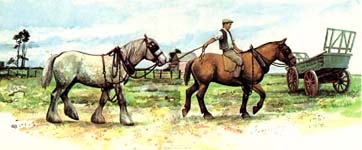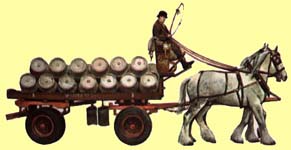|
|
The Shire |
|
|
|
The Shire |
|
 Originating in England, the Shire is a brachymorphic horse believed descended from the Great Horse. The Great Horse was the medieval charger used in jousting, and it derived from the most powerful draft horses in northern Europe, with some influence from Oriental blood. The Stud Book for the Shire was established in 1878. Originally the Shire was used for drawing carriages, later in agriculture and for drawing omnibuses. The Shire's numbers declined in the 1950s, but the centenary of the foundation of its Stud Book has brought a revival in the breed. The breed is nationally important in Great Britain.
Originating in England, the Shire is a brachymorphic horse believed descended from the Great Horse. The Great Horse was the medieval charger used in jousting, and it derived from the most powerful draft horses in northern Europe, with some influence from Oriental blood. The Stud Book for the Shire was established in 1878. Originally the Shire was used for drawing carriages, later in agriculture and for drawing omnibuses. The Shire's numbers declined in the 1950s, but the centenary of the foundation of its Stud Book has brought a revival in the breed. The breed is nationally important in Great Britain.
As English as the British bulldog, the Shire is considered by many as the supreme heavy draft breed. Called "Shire" from the Midland shires of Lincoln, Leicester, Stafford and Derby, this breed descends from England's medieval war horse. The original Great Horse came to known as the English Black during the short period when England was a commonwealth. The principal influence of the modern massive Shire was the heavy Flanders or Flemish Horse. Dutch contractors brought their strong horses with them to aid in draining the English Fenlands in the 16th and early 17th centuries. These were likely crossed with the English stock, as well as the Friesians, which contributed a better movement to the English Blacks. The King's Household Cavalry were still mounted on the Old English Black during the reign of Charles II.
The Packington Blind Horse, who stood at Ashley-de-la-Zouche between 1755 and 1770, is recognized as the foundation stallion of the Shire. This horse is listed in the first stud book. The name for the breed - Shire - was not used until 1884.
During medieval times in England, the Great Horse was developed to be strong enough to carry a knight in his plate armor and bearing heavy weapons, and yet still be agile in combat. The horse would not be mounted until just before battle, but was led by the knight's squire on his right. Thus the war horse became known by "Destrier," which is derived from the Latin "destrarius" meaning the right side.
The Shire and Clydesdale are sometimes described together as they are often difficult to differentiate, and it is easier to compare them side by side. The Shire was first bred in the counties of the English Midlands, as Yorkshire and Hampshire, from which it derives its name. The Clydesdale was named for the River Clyde which flows through Lanarkshire, Scotland, where it was developed.
The Clydesdale appears to have developed more toward the characteristics of the Shire rather than the other way around. Today these breeds share a very distinctive "leggy" look when they are compared to other heavy breeds. This is due to use of these horses for transport instead of agricultural work. Conspicuous not only for size, these two breeds have a combination of vivid body colors, white markings, a long lean head, and long "feathered" legs with a high stepping gait.
While the Shire is considered the tallest of the heavy horses, it and the Clydesdale are almost equal in size. The Shire is from 17 to 18 hands high, with the Clydesdale often the same height, but sometimes it is shorter. They both weigh an average of two thousand pounds. Shires are usually black, but they may also be bay, brown or grey. And while the Clydesdale may be any of these colors, it is most commonly bay. A roan Clydesdale could never be mistaken for a Shire, as Shires are never roan.
White markings on a Clydesdale will often extend from its foot right up to its belly, sometimes spreading in a mottled fashion. This pattern is far less typical in Shires, and some may have no white markings at all. Though a Shire without white markings would be rare, the ideal would have four white feet. And while many horses have a star or longer blaze, the Clydesdale shows the least amount of restraint, occasionally with its head almost entirely white. This unique pattern is called a lantern.
Taking a closer look at the legs, the white feathering is carried to such an extreme in both the Shire and Clydesdale. When this feathering is properly groomed, the flowing hair adds a striking accent when a team of these horses comes trotting along in a parade or any other event. Feathering can quickly turn into a handicap under such sever conditions as wet soil or frost, therefore the unpractical trait is not carried to such an extreme in other heavy breeds.
Although there is really as much debate about the history of these "Great Horses" of England and Scotland as about their history, the lineage of these two follows parallel lines and have many interchanges. There are some who believe that these are crosses between hardy indigenous pony types and imports of the taller horses from the Continent. The Exmoor is probably the best known of the ponies, and the Continental horses are thought to be of Flemish or Friesian descent. there are others who believe that these horses are descendants of horses brought to England in the 11th Century. Dutch horses were later imported into England for help in draining the Fenlands. On this very fertile soil, the biggest heavy horse breed was developed - the Shire. While other breed names as Clydesdale and Suffolk were already known, the Shire original seems to have been "The Big Black Horse."
Britain used heavy horses in warfare, as well as for transport and agriculture by those who could afford their upkeep. Various Royal acts regulated breeding with purposes to improve size and quality, and there have been English laws from time to time prohibiting the export of heavy horses to Scotland. This would indicate that there have been exchanges of horses between England and Scotland, and such an exchange would affect either breed's purity. Some outstanding Shires were bought by Scottish breeders in the mid-19th Century to be bred with local mares, thus creating the modern Clydesdale.
When it comes to the breed societies, these seem to have spread simultaneously throughout the Western world of horse-farming during the latter half of the 19th Century and early 20th Century. This is a rather short time span in which evaluation of the relative purity of any breed would be limited. Practices of cross-breeding were so common at that time and there was comparatively uncontrolled breeding over the many prior centuries. The Clydesdale had become a well-established breed for over half a century when the Clydesdale Horse Society was founded in 1877. Following the Scot's initiative, the English created their own society the very next year, originally calling it the Cart-Horse Society. Perhaps this was due to the inherent problems of identifying Shires, and six years later it was renamed to the Shire Horse Society.
Now Shires and Clydesdales do much the same tasks as those of the other heavy breeds, but they were never used in North America for work in the fields, in part due to the heavy feathering. Both can still be found doing odd jobs in agriculture and forestry. The main function of these horses is ceremonial, and in processions and displays. Though the Shire may no longer be found in significant roles in agriculture, there are still many popular plowing matches held in England. The Shire is the traditional brewery horse in England, and its popularity and advertising value alone more than justifies its use. A horse with a docile and good-natured temperament, the Shire is strong, having good endurance, and is well adapted to heavy draft and farm work. At the Wembley Exhibition in 1924, a pair of Shires pulling against a dynameter (an instrument for measuring power) exceeded the maximum reading. It was estimated that they had exerted a pull capable of moving 50 tons.
 This is the world's tallest horse, generally standing 16.1 to 17.3 hands at the withers, there are cases of horses reaching a height of 19 hands. Weight can vary from 1,760 to 2,200 pounds, but the taller horses can weigh up to 2,640 pounds, and the more massively built horses from 2,240 to 2,688 pounds. Shire coat colors may be
bay,
brown,
black,
chestnut or
grey, and they have frequent white markings. The most popular Shire color is the traditional black of the breed's ancestors, with white feathering.
This is the world's tallest horse, generally standing 16.1 to 17.3 hands at the withers, there are cases of horses reaching a height of 19 hands. Weight can vary from 1,760 to 2,200 pounds, but the taller horses can weigh up to 2,640 pounds, and the more massively built horses from 2,240 to 2,688 pounds. Shire coat colors may be
bay,
brown,
black,
chestnut or
grey, and they have frequent white markings. The most popular Shire color is the traditional black of the breed's ancestors, with white feathering.
Small in relation to the body, the head has a rather convex or "Roman" profile, a broad forehead, pronounced jaws, and long ears. The prominent eyes should be large and docile in expression, indicating the kind disposition of this breed of "Gentle Giants." For a draft horse, the arched and muscular neck is quite long, running into a deep, oblique shoulder. The withers are fairly wide, continuing the line of the neck. Is has a broad and muscular chest and the shoulder is long and sloping. The average Shire stallion's girth measurement is six to 8' and is combined with a broad, powerful chest. These are factors which indicate the horse has a good, healthy constitution.
The Shire has a short back, and a croup that is sloping but not too powerful. The thick, powerful musulature, particularly over the loins, and the wide sweeping quarters, along with the shortness of the back, exemplify the "strength" structure, which when combined with the weight are characteristics that are essential in the draft horse.
The rather short legs are well-muscled and feathered below the knee and hock. The limbs are clean and hard, the measurement of flat bone being 11 to 12 inches. The leg joints are broad, the cannons fairly long, the pasterns short, and the foot sound. The Shire's hocks have to be broad and flat, and set at the correct angle for optimum leverage and they are carried close together. Hooves must be open, very solid and perfectly shaped. The hocks and hooves are the most important features of the draft horse. the horse's action is straight from the front and from behind.
 For more information on Shire draft horses visit:
For more information on Shire draft horses visit:

|
© 1997-2007
NW Breyer Horse Club & Refiner of Gold Creations Equinealities in place since 1997, Section in place 2001, Updated 3/13/2007 |



|
| ||

|
|||||